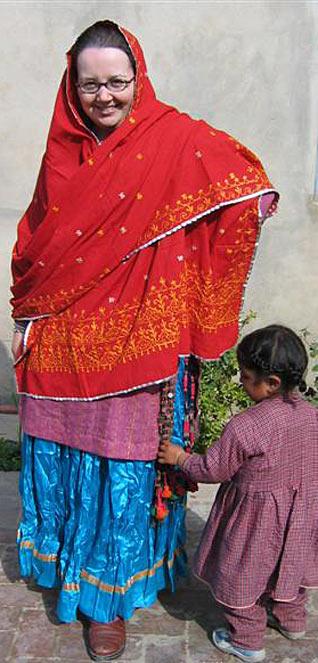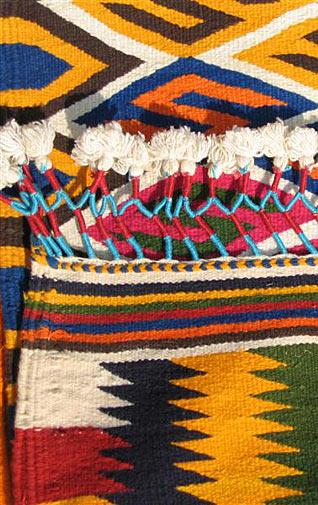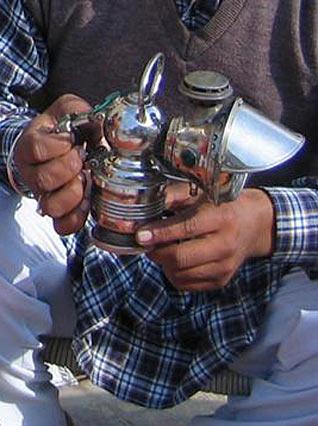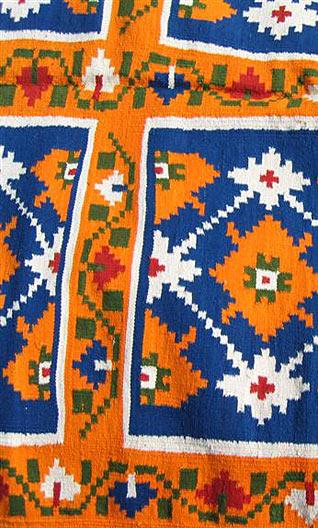Art
Heirlooms
by NICOLA MOONEY
What do colourful durries, antique phulkaris and lehngas, an early twentieth-century British camera and bicycle lamp, a mid-twentieth-century photograph album, and a hundred-year-old burqa have in common?
They were all displayed to us with love - and, not insignificantly, humour - on a recent visit to the Punjabi village home of a rural Malwai Sikh family. Each item seemed a deeply meaningful commentary on the vast scale and pace of social change witnessed by Punjabis in the past century.
These treasured pieces of local material culture are also indelible reminders of the warm hospitality and sociability of Sikhs.
Although our visit was planned, if not for a serendipitous breakdown, we would not have been there that mid-winter morning. We had arrived the day before to speak to members of this distantly-related family about the rewards and challenges of farming amid social change.
But a reticent gearbox had stranded us two villages away, and despite the mechanical expertise of my husband, father- and brother-in-law, it remained uncooperative. Although the family's several vehicles were all out in use that afternoon, a rescue effort was mounted, and we were welcomed three hours late, dusty and shaken from driving the muddy rural lanes in an ancient borrowed Maruti without springs or shocks.
Our car was delivered two hours later by the family's intrepid nephews, who managed to restore it briefly to working order after the local mechanics were found to be still celebrating Lohri with rather excessive abandon.
But we would have to spend the night in the village as the car could not be fixed right away, and while the prospect of spending the evening in near zero degree C temperatures with only cardigans over our daytime clothes was rather daunting, we were to be richly rewarded for this happy accident.
While in the village, we were served a delicious lunch of chhole, saag, dahi and kheer, followed by steaming chai, and treated to a warming daal-roti dinner and the customary glass of hot milk - in this case farm-fresh - before bed.
Best of all, the family indulged us in a lengthy fireside discussion in the farmyard throughout the evening. We spoke widely and meaningfully about farming, education, modernization and development in Punjab, about migration from it and nostalgia for it.
While we talked, we fed cotton twigs to a fast-burning bonfire, ate moong-phali and reori, and laughed at the antics of a bakri da memna wanting to sit on the manjaa with us.
The next morning, after a hearty breakfast of paraanthe, as we sat about the courtyard on manjaas, warming ourselves in the strengthening sun, a treasure-trove of heirlooms was pulled from the family's storage chests.
The display was prompted by the family patriarch's concern to show us his farm account-book, which sadly noted that the profits to be earned in farming have not kept pace with the costs of everyday life in the period since the Green Revolution.
In a nostalgic mood, uncleji took out a small family album which held carefully preserved photos taken since the 1950s. He relayed that some women in this village used to veil themselves, and that his womenfolk in fact possessed a Muslim garment that he referred to as a burqa.
The intrigue of this instance of intercommunal traditions was soon made vivid when a few minutes later, his wife appeared with a folded garment, immaculately white, and edged with inlaid lace. She told us that it was more than a century old.
This decidedly non-Sikh tradition - which neither my Sikh companions nor I in my decade of research on the Sikh community had previously encountered - is nonetheless a variant of the chaadar practice in which married rural Sikh women covered their heads in white or cream shawls when in public.
Although Sikh chaadars were typically simple and unadorned, the lace finishes and formalized fastenings of this particular garment seemed to suggest that it could be mistaken for a burqa. Despite this unusual nomenclature, the custom it represented appears to have been particularly existent amongst the Muslims of Punjab, although it has completely disappeared in the years since Partition.
The family chests open, phulkaris, lehngas, and durries followed in quick succession, and in short order we were invited into the store room to look inside the almareeh ourselves. The textiles were exquisite: richly coloured, finely embroidered and of exceptionally good cloth. Most of the pieces had been made by auntieji herself in preparation for her marriage.
She wore many of the phulkarian as a young bride, and the durries were prepared as part of the bistre, or bedding sets, she brought in her dowry. I had heard similar feats of craftswomanship from my mother-in-law and her kinswomen. While durries are no doubt still in village production, and available both in khadi shops and the international market, several fruitless searches for phulkaris in the past decade have all but convinced me that this is a dying art.
Indeed, phulkaris are fast becoming museum pieces. It is almost inconceivable that the mass-produced machined textiles made today will stand the test of time, and moreover, the rigours of village use, to be ‘unearthed' in almost pristine condition five decades or more hence.
Among the treasures, I came across several jholas that auntieji had embroidered several decades ago: she told me that these gems were used by women and men alike when small items had to be carried about the village or from the bazaar.
The logo-emblazoned plastic lifaafe with which almost all shopping in India is done today seems not only environmentally unsound but profoundly sad: unique, beautiful, locally-crafted, and moreover sustainable shopping-bags cast aside in favour of the consumerist trappings of global modernity.
As the trend towards the conspicuous consumption of everything new continues to make inroads in Punjab, Sikhs visiting their village homes in the future may be deprived of such a rich and genuine material experience; the plasticized mahaul of the modern heritage resorts, sad testaments to cultural authenticity, may be all that remains.
While we both examined the silken embroideries, it was my husband that came across the camera and cycle lamp. An interesting gender dynamic then began to play out in this display of treasured heirlooms. The men were happy to fiddle about with the camera and lamp, material tokens of colonialism and early technologies of modernity.
Meanwhile, the women, young and old, caressed and admired the textiles in their hands. Interestingly, we repeatedly declined our elders' requests to model the clothing. In contemporary rural Sikh families, the notion of ghund is still charged: it marks the acquiescences and struggles of younger daughters-in-law adjusting to the familial demands of married life, while conjuring up emotionally complex memories of prescribed behaviour in the presence of their in-laws.
It was only when the family patriarch put the burqa on for laughs - over pagree and all - that we women relented: we each then tried the ghagra and a phulkari dupatta. The undoubtedly comic spectacle of an angrezi bahu in garments that had been relinquished to the family store room half a century ago, along with its material companions, spoke of ongoing cultural encounters and pronounced social change.
At the same time, this entire village visit spoke of our immense privilege in witnessing and for a while sharing in the tangible past of our generous hosts.
Dr. Nicola Mooney is Adjunct Professor of Anthropology at Mount Allison University, New Brunswick, Canada.
[Photos: by Dildeep Singh Dhillon and Nicola Mooney. Top of this page - The author poses in auntieji's phulkari and ghagra, while the family's youngest grand-daughter plays with its ornate naara. Bottom photo on this page - a Punjabi durrie whose pattern resembles a phulkari baagh. Second photo from the bottom - an antique bicycle light. Third photo from the bottom - two vibrant handloomed durries. Thumbnail photo - an antique box camera.]
Conversation about this article
1: Manjit Singh (U.S.A), May 09, 2007, 4:57 PM.
Thanks for sharing the article and pictures! It was nice to read of your experiences. My "angrezi wife" and youngest son are just recovering from jet lag after a month in a Punjab village for the first time! Both of them travelled in Punjab, Shimla, Chandigarh, Amritsar! They really enjoyed the Sikh hospitality!
2: Surabhi (Malaysia), June 19, 2007, 10:16 AM.
The article brings a fine update on current state of Punjabi handicrafts alongwith an overall desi experience ... the winter, smells, flavours, etc. The pictures are interesting too. Thank You!






